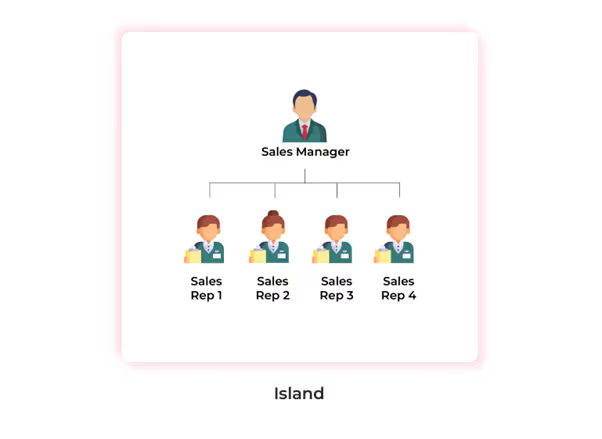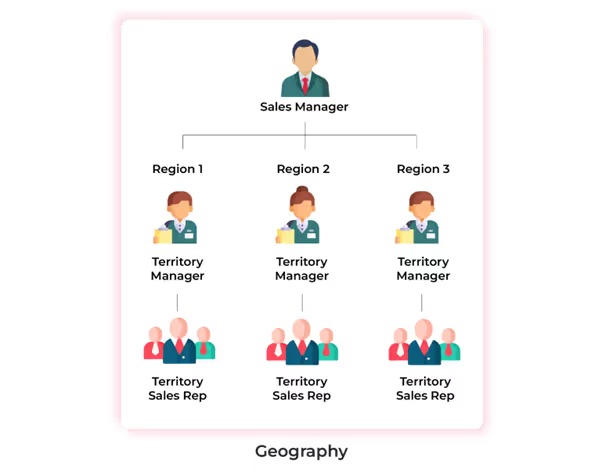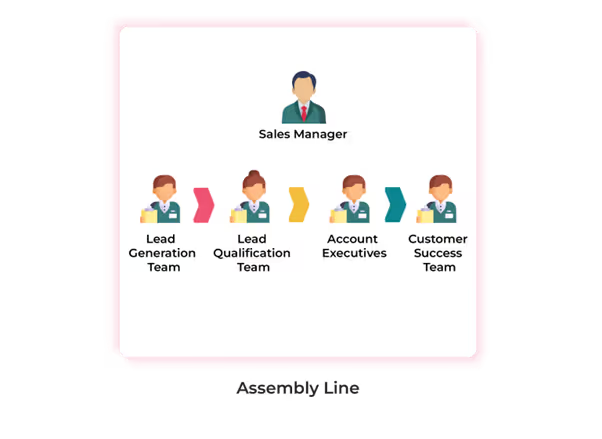
Blog
Designing the Perfect Sales Team Structure: Key Elements
August 23, 2023


Key Insights
How should a sales leader go about building their team?
The New Science of Sales Force Productivity published in the Harvard Business Review, points out that successful sales leaders are departing from the old ways of relying on their top talents to remain competent and are taking up a more scientific approach to reshape their tactics in response to changing markets.
These data-driven approaches show how sales leaders have understood the need to upgrade with the changing markets, trends, and customer behavior.
Having a calculative approach towards the sales process will help in making informed decisions which will make a greater impact on the overall sales performance and improvement.
Designing your sales team structure is one crucial step toward achieving these goals.
In this article, we will explore sales team structure, its various models, the best sales team structure, and 10 best practices that will help in building a strong sales team.
So without much adieu, let's scroll down.
What is sales team structure?
Sales team structure refers to the way you have grouped your sales reps and organized your sales team to ensure an efficient and high-performing salesforce.
An effective sales team structure understands the market, the organizational structure, and their employee capacity to build a team that can cater to the sales requirements without falling short of their performance or potential.
There is no definite way to structure your team and most sales leaders implement this by taking into consideration the territory, nature of work, product or service they deal with, etc.

What are the types of sales team organizational structures?
There are various ways sales leaders structure their teams. Some of the most common ones are:
- Island model
The island model follows a very simple structure where a sales manager oversees the work of a group of sales reps. In this model, the sales reps work independently using their own style to find leads, make cold calls, and close the deal. There is no definite sales process or strategy that they need to follow.

- Geographical model
Under this model, the organizations divide their sales team based on geographical locations, with each team having specific sales roles and responsibilities, as well as individual sales quotas, strategies, and processes to close deals. This model helps companies track their profit from each location and also apply successful sales strategies in other locations to ensure uniform growth.

- Assembly line model
If you have seen Charlie Chaplin’s Modern Times you will know what an assembly line is. The product goes through a conveyor belt and each employee has a specific work to do. When the product reaches the end of the conveyor belt it is a finished product.
In an assembly line, the customer goes through a sales pipeline and at each stage, a specialized salesperson will lead them towards closing the deal. This model is divided into four stages. First the lead generation team, lead qualification team, account executive team, and customer success team. This model helps in giving customers a specialized experience at each stage of their customer journey.

- Pod model
Instead of pitting various teams in your company to close a deal like in an assembly line model, a Pod model brings various members of the lead generation, lead qualification, account executive, and customer success teams to form smaller but effective groups.
A Pod model will have a few members from all four departments to form a team of 6 members. Each Pod will take their customer from the beginning of their customer journey to the closing of the deal. This ensures better teamwork and coordination among the members to achieve their targets.

- Divisional model
A divisional model is suitable for a larger business that has more than one product or service. Here the sales team is divided based on the product or service they deal with rather than the work they do. Each divisional will have its own set of employees to meet its sales quotas and achieve its targets.

From the vast variety of sales organizational models, a sales leader will choose what best suits their team.
What is the best sales team structure?
There is no one best sales team structure that any sales manager can vouch for.
Each model has their pros and cons and a good sales leader can understand what best suits them by considering various factors including their industry, product, number of sales reps, organizational size and structure, etc.
For example, an island model suits a real estate sales company. For an automobile company territory sales model helps better track their sales and profit. An organization with a bigger sales team can make use of the assembly or pod model. While a larger company like Unilever with multiple products a division model will work.
Hence, it's not possible to say that a particular model is tailor-made for your industry or your company. It is a very subjective process where several various factors have to be considered and weighed before making the final decision.
Best Practices for building strong sales teams
Determining which sales team structure best suits your salesforce is just the tip of the iceberg. Other crucial steps must be consistently followed to ensure that your team is high performing, contributing to a favorable return on sales ratio.
Here are the top 10 practices for building a strong sales team.

- Hire the right talent
Choosing the right person for the job is having the work half done. A talented and skilled employee can take your business to better growth. Organizations must have a clear picture of the potential candidate they are looking for and test them to find that suitable member for their team.
- Train them well
Sales are work that requires constant feedback and improvement. Sales managers must ensure they give a proper briefing to new joiners, regular training sessions for the sales team as well as one on one coaching sessions for a better understanding of your salesperson and more personalized feedback for improvement.
- Create a growth ambiance
Sales is a competitive job so it's important that you keep them motivated. Sales managers must set achievable sales targets by understanding the potential of their team members, guide them to various opportunities they can explore for improvement, and ensure they upskill their potential through regular learning.
- Encourage teamwork
From the above sales organizational models, it is clear that closing a deal becomes faster when it's a combined effort and aligns with a modern sales strategy. Sales managers must come up with a sales process that encourages teamwork and ensures regular coordination between them.
- Incorporate digital tools
The efficiency and seamlessness that digital tools bring have made it an inevitable part of everyday sales operations. These solutions not just make routine work easy but also keep track of the work progress. Due to this reason, 43 percentage of salespeople use sales intelligence tools in tracking their sales pipeline which is a 54% increase compared with the 2018.
- Have a sales strategy
Having a roadmap, such as a well-defined sales performance template, on how to achieve your quotas and targets helps sales managers plan their sales process and better prepare their salesforce. A sales strategy, along with a sales performance template, thus helps in giving a framework for the team to achieve their objectives and also gives clarity to each member on what is expected of them to accomplish.
- Share customer feedback
Feedbacks are important to know how we are performing in our job as well as to understand areas of improvement. Sharing customer feedback will help sales reps to understand the effectiveness of their sales process as well as work on their weak points to enhance their sales performance. Regular sales performance evaluation through feedback loops is essential for continuous growth and development.
- Design defined KPIs
Key performance indexes are defined metrics that help sales managers evaluate their team’s performance, as well as aid sales reps in understanding what is expected of them during the sales kick-off. This provides clarity on the anticipated level of performance, target achievements, and the potential growth that the salesforce can achieve in their work.
- Built effective incentive programs
An effective incentive program can enhance sales performance, employee engagement, work commitment, dedication, and more, playing a pivotal role in boosting sales team motivation. It is a motivational tool that can ensure positive behavior from your salesforce while keeping them focused on their targets and achievements.
- Celebrate their success
The significance of employee validation is immense. A workforce that feels appreciated for the work they do and the goals they achieve will always be motivated to work harder as well as be loyal towards the growth and success of the organization. Hence, sales managers must ensure that they celebrate their team’s milestones and motivate them to strive more.
Employees are the backbone of any organization. Building a trusted, committed, and dedicated workforce will help companies optimize their operational efficiency as well as growth potential.
Takeaway
There are various ways an organization can optimize its business operations.
But understanding what best suits your business structure, operations, and employees will determine the effectiveness of these tools and techniques.
There is no perfect sales team or sales structure. It is only through constant research and trial and error that perfection can be achieved.
One such tool that plays a huge part in building that perfect team is incentive compensation, which is closely tied to the design of an effective sales incentive structure.
Having an effective sales commission program and management solution will ensure that the needs and requirements of your sales team are timely met and that they are kept satisfied and motivated.
Automation of sales commission management is a seamless way to achieve these goals.
And Kennect helps you in automating your sales performance management and incentive compensation management to achieve operational efficiency. For more information, Book A Demo today.
ReKennect : Stay ahead of the curve!
Subscribe to our bi-weekly newsletter packed with latest trends and insights on incentives.
Thank you! Your submission has been received!
Oops! Something went wrong while submitting the form.
Your data is in safe hands. Check out our Privacy policy for more info






%20(1).avif)







